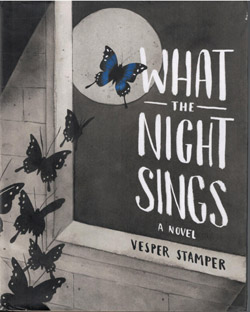What the Night Sings by Vesper Stamper; © 2018, Alfred A. Knopf, ISBN 9781524-700376; 266 pages including appendices, $19.99.
By Donald H. Harrison

 SAN DIEGO –Set in the Bergen-Belsen concentration camp after the Holocaust, but with a lengthy flashback to the events that preceded the main story, this novel tells of a teenage girl’s struggle finding something to live for in the wake of the deaths of her entire family. Making matters even more complicated for Gerta Rausch is the fact that until she and her father were seized by the Nazis, she was not aware that she was Jewish. Her father and Christian step-mother had hidden this fact from her so as not to worry her, or perhaps to avoid the possibility that Gerta might inadvertently betray this information to the Nazis.
SAN DIEGO –Set in the Bergen-Belsen concentration camp after the Holocaust, but with a lengthy flashback to the events that preceded the main story, this novel tells of a teenage girl’s struggle finding something to live for in the wake of the deaths of her entire family. Making matters even more complicated for Gerta Rausch is the fact that until she and her father were seized by the Nazis, she was not aware that she was Jewish. Her father and Christian step-mother had hidden this fact from her so as not to worry her, or perhaps to avoid the possibility that Gerta might inadvertently betray this information to the Nazis.
Ignorance, they say, is bliss, and until reality crashed through her doors, Gerta practiced singing operatic arias, her girlish soprano voice encouraged by her step-mother, the well-known opera singer Maria Büchner. Gerta had believed she would soon be privileged to make a debut with a local opera company. In addition to voice lessons, Gerta learned to play her father’s viola. He had been part of Köln, Germany’s orchestra, but after moving to Würzburg, he appeared less and less in public, preferring to keep the curtains of their apartment closed and lavishing his beloved music on Gerta, his willing pupil.
When this naïve young girl was sent to Theresienstadt and later to Auschwitz, where her father was gassed, music was the only remaining constant in her life. Carrying her father’s viola case to the selection lines at Auschwitz, she was sent by Josef Mengele to the women’s orchestra, a ghastly assignment in which she and others played classical music as other Jews were pulled off cattle cars, and divided by Mengele into groups who would live and groups who would die. At first, she tried to silently warn the incoming unfortunates that they must try to be placed in the line for workers, but her efforts were futile. So, she concentrated on playing the viola, keeping her eyes on her music. From Auschwitz near the end of the war, she was transferred to Bergen-Belson, where more than half-starved to death, she was near death at the time the camp was liberated by the British.
A young, religious boy named Lev helped nurse her back to health, but their worlds were very different. He had grown up in an Orthodox Jewish family in Poland, although he spoke a little German. She had grown up in a musically sophisticated, highly assimilated family in Germany. But whether she was interested in him romantically or not, Lev treated her with devotion. He had learned that Gerta had comforted his dying mother in her arms in the women’s barracks.
More closely attuned to Gerta’s secular lifestyle was Michah, an operative for the Haganah, who wanted to smuggle her and other young Jews to Palestine. Unlike Lev, Michah was sure of himself, unafraid to romance a woman, and Gerta fell for him in a big way. But going to Palestine? Learning a new language? Gerta had difficulty believing that her future was not in Europe, despite all. Her life was music, she thought. These men were a distraction.
Young adults, for whom this book is intended, will have to read further to find out how the love triangle turns out, and what become of Gerta. But along the way, they will be able to share Gerta’s predicament in self-definition, and empathize with a teenager who must decide what values, places, occupation, and partners she wants to occupy her future.
The book makes compelling reading, not only for young adults, but for older readers as well. I strongly recommend this novel, especially for anyone who struggles to understand the emotional impact the Holocaust had on its survivors.
*
Harrison is editor of San Diego Jewish World. He may be contacted via donald.harrison@sdjewishworld.com